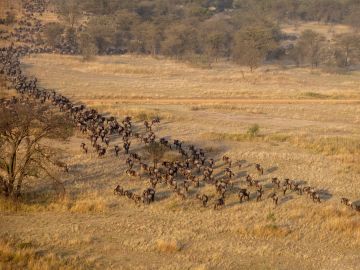
The Great Migration in Africa: Where, When & Why You Should See It
In what is one of the world’s most quintessential wildlife experiences, the annual Great Migration in Africa is an event like no other. Millions of Zebras, Wildebeest, and other antelope species make this incredible journey across Tanzania and Kenya every year, facing Crocodile- infested waters and terrestrial predators (Lions, Leopards, etc) along the way.

To witness such an event in the birthplace of humanity is an emotional experience that could never be fully captured by mere photos or words. The Great Migration takes place in some of the most wildlife-rich natural areas in the world, making the experience all that more rewarding.
This is one of those world travel bucket list items that we all dream of experiencing during our lifetime. Here’s a brief guide on where, when, and why every nature lover should see it!
Consisting of millions of animals, East Africa’s Great Migration is the largest terrestrial mammal migration in the world. Its stage encompasses some of the most breathtaking ecosystems on Earth, including the most well-known reserve on the continent, Serengeti National Park.
The migration is an endless circuit in which the circle of life is showcased in its purest form. Like the hands on a clock, a seemingly never- ending stream of fauna make their way across Africa’s landscape in search of food and water, never knowing how much time they may have left.
The Great Migration is a famously treacherous journey in which the animals must not only find food to sustain themselves, but also give birth to the future generations that will keep the annual migration alive. It’s a classic game of survival of the fittest, and its contenders are some of the most majestic and resilient creatures Africa has to offer.

Where to Witness the Great Migration At Its Finest
The Great Migration is unlike other natural events you might find elsewhere in the world. The unpredictable journey’s timing and exact locations are constantly changing, evolving based on current conditions.
Rain (and the lack thereof) is the main ingredient that dictates where and when the herds will be during a specific period of the year. The only thing you can rest assured of is the fact that the event will take place across Tanzania and Kenya.
But let’s explore some of the many East African National Parks and reserves that offer the best chance to see this natural spectacle:
Ngorongoro Conservation Area (Tanzania): Located in Tanzania’s north, the Ngorongoro Conservation Area is the place to see newborn Wildebeest and Zebras during calving season. The abundance of young prey also means you might have a greater chance of experiencing Lion, Leopard, and other predator attacks during your visit.

Serengeti National Park (Tanzania): This is definitely one of the best places to witness the Great Migration, as large herds of Wildebeest and Zebra begin to congregate. The Grumeti River makes for an imposing barrier which the animals need to gather up the courage to cross. It is also here where the Wildebeest will begin to mate, hopefully offsetting their population losses during the migration.
Mara River (Tanzania & Kenya): Animals that survive the Grumeti River crossing now face an even more daunting task. Crossing the turbulent Mara River will give them access to the fertile grasslands of the Maasai Mara. But the threat of crocodile attacks here increases considerably, often causing great panic among the herds. This makes the Mara River a great place to witness dramatic attacks, as well as the triumphant herds that manage to make it safely to the other side.
Maasai Mara National Reserve (Kenya): The animals that make it to these feeding grounds can now fatten up before returning to the Ngorongoro to give birth again. But they also face one of East Africa’s greatest densities of lions. The survivors will make their way south in a few months, leaving behind the big cats that preyed upon them to defend their home territories. The Maasai Mara also offers excellent sightings of Elephants and Giraffes, as well as rarer species such as the Topi.

When To Go: A Timeline of Highlights
January-March: At this time of year the great herds of Wildebeest and Zebra are spread out across the southern Serengeti and Ngorongoro Conservation Area. The majority of females will give birth during a 2-3 week window.
April-May: The herds will now move on to the Moru Kopjes and Seronera areas, en route to the Serengeti’s Western Corridor. This is not a great time or place to witness the Great Migration, as heavy rains and flooded roads make reaching the herds very difficult.
June-July: The herds will now begin to congregate and attempt to safely cross the Grumeti River. Mating also occurs during this time. Easily accessible camps along the river offer incredible safari options to witness the migration in progress.
August-October: The herds will cross over from the northern border of Serengeti National Park into the Maasai Mara Reserve during this period. They will face their hardest challenge, crossing the Mara River, which offers incredible wildlife viewing. Safaris on the Maasai Mara are wonderful for viewing not only the migration. but also a wide variety of local wildlife.
November-December: Now the herds will begin to make their way south through Loliondo. They attempt to time their arrival on the southern Serengeti plains as the much-needed rains finally begin to fall. The lucky ones will once again give birth to the next generation of East Africa’s migratory wanderers.